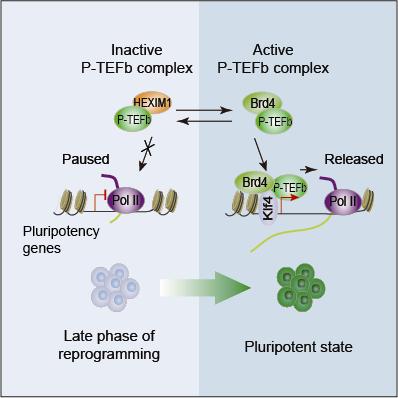Scientists at GIBH Discovered New Roadblocks for Somatic Cell Reprogramming
Professor Miguel A. Esteban and his team from Guangzhou Institutes of Biomedicine and Health, Chinese Academy of Sciences reported a new roadblock of somatic cell reprogramming on October 10th. This work was published online by the prestigious scientific journal Cell Stem Cell entitled "Transcriptional Pause Release Is a Rate-Limiting Step in Somatic Cell Reprogramming ". In this work, researchers discovered that in the late phase of reprogramming, RNA polymerase II was paused on the promoter of pluripotency genes and modulating the pause release of RNA polymerase II at the molecular level could accelerate this process.
Somatic cell reprogramming technology has potentiated development of regenerative medicine. It also provides an excellent model to investigate the mechanism of cell fate conversions in vitro. Previous studies showed that exogenous transcription factors SOX2, OCT4, KLF4 and c-MYC can interplay with many chromatin regulators and result in global epigenetic remodeling, thus leading to changes of transcriptional mode by RNA polymerase II on different genes. These changes will finally achieve the loss of somatic cell characteristics and the full reactivation of the pluripotency network. But how is the transcriptional mode changes regulated during reprogramming remains unknown.
Professor Miguel A. Esteban and his team analyzed the nascent RNA in somatic cells and embryonic stem cells, and also compared the RNA polymerase II binding pattern in reprogramming intermediates by ChIP-sequencing. They found that RNA polymerase II is engaged at pluripotency promoters in reprogramming but remains paused and inefficiently released. While the activity of transcriptional pause release factor P-TEF play an essential role for the release of paused RNA polymerase II. They also showed that bromodomain-containing protein 4 (BRD4) stimulates productive transcriptional elongation of pluripotency genes by dissociating the pause release factor P-TEFb from an inactive complex containing HEXIM1. Consequently, BRD4 overexpression enhances reprogramming efficiency and HEXIM1 suppresses it, whereas Brd4 and Hexim1 knockdown do the opposite. They further demonstrated that the reprogramming factor KLF4 helps recruit P-TEFb to pluripotency promoters.
This work thus provided a mechanism for explaining the reactivation of pluripotency genes in reprogramming and speculated a general mechanism for other types of transcription-factor-based cell fate conversions. The work was cooperated with BGI-Shenzhen, the Chinese University of Hong Kong, the University of Hong Kong, Hannover Medical School and University of Birmingham, and supported by the Ministry of Science and Technology of China, Chinese Academy of Sciences, the National Science Foundation of China, Bureau of Science, Technology, and Information of Guangzhou Municipality et al.

Transcriptional Pause Release Is a Rate-Limiting Step in Somatic Cell Reprogramming
picture from www.cell.com/cell-stem-cell/